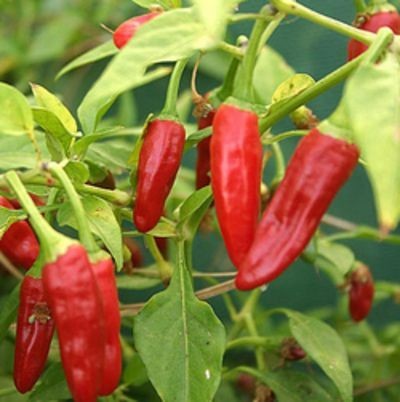
Common Name: Mirchi,
English Name: Bell pepper, Pod pepper
Botanical Name: Capsicum annum ( L).
Family: Solanaceae
Description: Fruits dull orange-red in colour, oblong-conical in shape,obtuse at the apex;two-celled varying from 12-25 mm in length and up to 7 mm wide at the centre. Sometimes attached to a five toothed, inferior calyx and a straight slender pedicel up to 2-3 cm long. Pericarp shriveled, translucent and leathery enclosing 10-20 flat reniform seeds 2-4 mm long.Odour characteristic and powerful; taste extremely pungent.
An annual herb growing up to 1 m in height, C. annuum is native to the tropical Americas and widely cultivated throughout the tropics and elsewhere. There is confusion regarding the classification of Capsicum species. Currently, all varieties of mild and hot peppers (not to be confused with black and white pepper derived from Piper nigrum and related species) are considered as the fruits of a single species, C. annuum and its many varieties, or of 2 species, C. annuum and C. frutescens. Current practice is to classify the pungent varieties of pepper (chile peppers or cayenne peppers) as C. frutescens, and the milder-flavored sweet peppers (bell peppers, sweet peppers, green peppers) as varieties of C. annuum; however, most botanists agree that they should properly be regarded as varieties of a single species.
Chemical Constituents: The principal compound for the pungency is capsaicin and related capsaicinoids. In ‘mild' peppers it is as low as 0.001 to 0.005% and in ‘hot' it is up to a level of 0.1%.The chemical composition of the Capsicum species includes a fixed oil, capsaicinoids, volatile oil and carotenoid pigments mostly capsanthins.Apart from capsaicin, the taste of paprika is mostly due to its essential oil. The scent of paprika is due to a range of alkylmethoxypyrazines.Ripe paprika contains about 6% sugar and 0.1% of vitamin C. Capsicum derive their colour in the ripe state mainly from carotenoid pigments, which range from bright red (capsanthine, capsorubin and others) to yellow (cucubitene). Total carotenoid content in dried chilli is about 0.1 to 0.5%. Some varieties of capsicum contain pigments of anthocyanin type and develop dark purple, aubergine-coloured or black pods in the last stages of ripening.
Properties: Capsicum is used as a natural fat burner and pain killer, to treat ulcers, increase metabolism, improve circulation, boost the immune system and aid digestion. It is used as a tonic for the heart, kidneys, lungs, pancreas, spleen and stomach and to treat herpes, shingles and rheumatism. It is also known to combat chills and has been used to treat bunions, psoriasis, pleuritis and pericarditis and has been indicated for preventing heart disease.
Studies have shown that it can raise metabolic rates by as much as 25%, aid in treating herpes, shingles and Raynauds disease, and help prevent heart disease and ulcers. Cayenne is also used as a natural pain killer with anti-inflammatory properties. Capsicum may be used internally or externally to treat arthritis, bunions, psoriasis, and muscle and joint pain. Recently, Capsicum has been used successfully to treat patients with cluster headaches, a particularly painful type of headache.Used externally, Capsicum liniment may soothe the stiffness and pain of rheumatism and arthritis.
Used in the following MATXIN products: